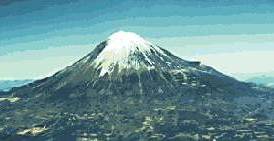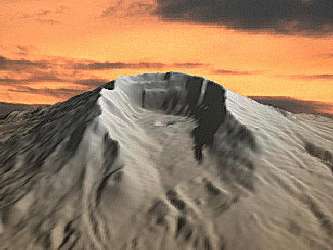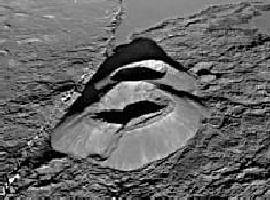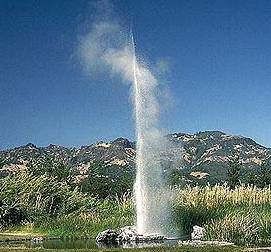|
Extrusive Igneous Landforms or Volcanos
Volcanos are the most easily recognized expression of igneous activity.
Unpredictable in temperament, they have given rise to legends in many a
culture. Even today, the tragedy of Mount St. Helens in Washington State
and Mount Pinatuba in the Philippines are grim reminders of the internal
forces that still shape our active planet.
Viscosity
Volcanos vary as greatly in their appearance as they do in their activity.
The primary factor that controls both of these is the viscosity
(resistance to flow) of the lava which feeds the volcano. This viscosity,
in turn, is controlled by the temperature and the chemical composition
of the lava. The cooler the lava, the more viscous it is. Compositionally,
the richer in iron and other mafic elements, the less viscous (more fluid)
the lava will be. The richer in felsic materials, the more viscous it will
be at a given temperature. Given the enormous range of temperatures and
compositions possible, it should come as no surprise that no two volcanic
eruptions will be exactly alike. As conditions change in the magma chambers,
so will eruptions. and each volcano is unique.
Viscosity, in turn, controls three things: 1) the shape of the volcano,
2) the amount of ash spewed out during the eruption, and 3) the violence
of the eruption. The more fluid the lava, the longer it will remain
mobile, and the greater its tendency to spread over the countryside; therefore
the less steep the slopes of the volcano. In a very fluid lava there is
also a lesser tendency to splatter, and therefore less ash and other fragments
are ejected. Finally, because the gases are less likely to be trapped when
the lava is fluid, they will not build up enough pressure to blow up the
volcano. Eruptions will be quiet, rather than violent or explosive.
TYPES OF VOLCANOS
There a five basic types of volcanos or volcanic landforms:
|
|
1. Plateau Basalts
Also called flood basalts, they are volcanic outpourings characterized
by extremely fluid basaltic lavas. In most cases the lava does not erupt
from clearly defined cones and craters, but wells out from fissures. The
molten material is so fluid that it does not pile up into singular, discrete
landforms, but spreads out into horizontal lava flows which cover an area
like the flood of a river. Eruptions are quiet, and virtually no volcanic
ash is ejected. In times past, flood basalts covered portions of Washington
and Oregon with flows nearly two miles thick. Similar flows formed sections
of Iceland and India's Deccan Plateau. They are also associated with rift
features and basaltic outpourings form the ocean floor. |
|
2. Shield Volcanos
Shield volcanos are more readily recognizable as volcanos than are flood
basalts. They usually have a well defined central cone. Their eruptions,
also composed of basaltic flows, can also occur as fissure eruptions and
are of the quiet type. Because of the low viscosity of their lavas, these
volcanos tend to be quite broad and to have little ash content. Their slopes
are gentle, rising on the average 5o from the horizontal. The
Hawaiian Islands, the largest mountains in this world, are the tops of
shield volcanos that rise over five miles from the ocean floor, but spread
out over one hundred miles laterally. The largest volcano in the solar
system, Mons Olympus on Mars is also a shield volcano. |
 |
3. Composite cones (= Stratovocanos)
These often magnificent mountains are what most people visualize when the
word volcano is mentioned. They include in their ranks such famous landmarks
as Mt. Kilimanjaro in Kenya and Mt. Fujiyama in Japan. Steeper than shield
volcanos, their slopes rise at angles of 30o from the horizontal,
steeper near the summit and flatter near the base, and they are made up
of alternations of lava flows and ash falls. Because of the greater viscosity
of their lavas, their eruptions can be quite violent and dangerous, as
evidenced by the self destruction of Krakatoa in 1886. |
 |
4. Plug Domes.
Similar in appearance to composite cones, they are some of the most dangerous
of the large volcanos. In this type, the lava is so viscous that it rises
slowly, in semi solid form, with a consistency akin to toothpaste. As this
lava reaches the surface, it has a tendency to congeal into a dome that
plugs the volcano, trapping gasses. Often the pressure builds sufficiently
to violently blow out the dome. Commonly, the eruption resumes with the
formation of a new plug followed by a new explosive episode. They are rich
in ash. The devastation wrought by Mt. St. Helens and Mt. Pinatuba in the
Philippines, clearly demonstrate the dangers associated with this explosive
type of volcano. |
 |
5. Cinder Cones
Cinder cones are small, steep-sided, ash-rich, short lived cones, which
discharge virtually all pyroclastics (ash, cinders and lapilli) and no
lava. |
 |
Associated features: geysers and geyserite, hot springs, fumaroles. |
|
Importance of volcanos
Volcanic eruptions are indeed awe-inspiring and dangerous. Damage is often
caused by lava flows which cover large areas. It is well to keep in mind,
though, that volcanic ash affects much larger areas than lava flows. These
fine particles, ejected to great heights, destroy vegetation as they fall
back onto the earth's surface. As Benjamin Franklin first noted, they also
affect climate by blocking out sunlight. Ash-covered areas are also susceptible
to mass movement. Sudden melting of snow or ice from the flanks of a volcano,
or torrential rainfalls commonly associated with eruptions will release
large amounts of water which mix with the ash and cause mudflows (lahars),
which often devastate areas miles away from the actual eruption. Finally,
volcanic gases, a mixture of superheated steam and poisonous gases represent
an additional danger. In 1902, 30,000+ people were killed by a fiery cloud
of volcanic gases which annihilated the city of St. Pierre, on the island
of Martinique, in a matter of minutes. These gases are also atmospheric
pollutants. EXPAND
Nonetheless, it should be kept in mind that volcanos provide much that
is beautiful. Volcanic ash in the atmosphere causes spectacular sunsets.
The new lands created during eruptions provide fertile soils which enrich
the area. Volcanos are the sites of the creation of new crust. Finally,
the gases they have emitted since the dawn of time have given us our atmosphere
and oceans. |





